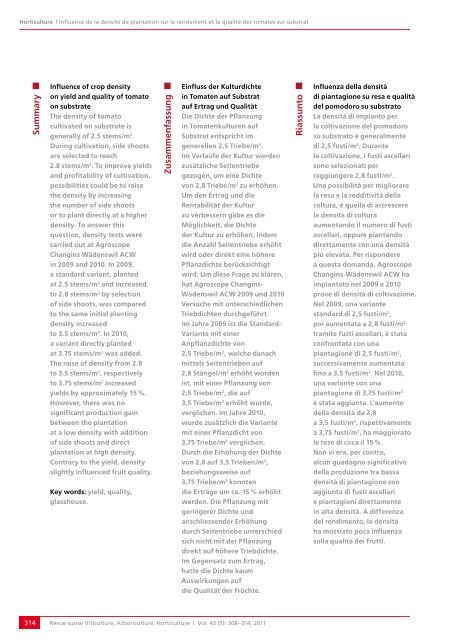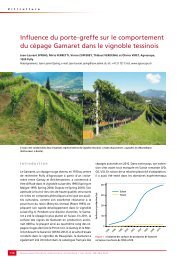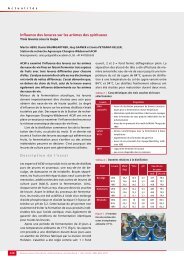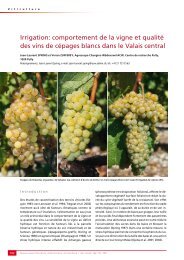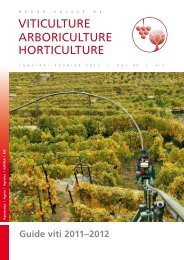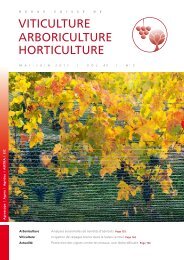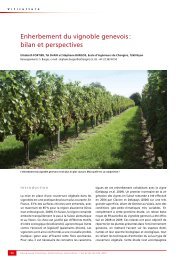Télécharger le PDF - Revue suisse de viticulture arboriculture ...
Télécharger le PDF - Revue suisse de viticulture arboriculture ...
Télécharger le PDF - Revue suisse de viticulture arboriculture ...
Create successful ePaper yourself
Turn your PDF publications into a flip-book with our unique Google optimized e-Paper software.
Horticulture | Influence <strong>de</strong> la <strong>de</strong>nsité <strong>de</strong> plantation sur <strong>le</strong> ren<strong>de</strong>ment et la qualité <strong>de</strong>s tomates sur substrat<br />
Summary<br />
314<br />
Influence of crop <strong>de</strong>nsity<br />
on yield and quality of tomato<br />
on substrate<br />
The <strong>de</strong>nsity of tomato<br />
cultivated on substrate is<br />
generally of 2.5 stems/m 2 .<br />
During cultivation, si<strong>de</strong> shoots<br />
are se<strong>le</strong>cted to reach<br />
2.8 stems/m 2 . To improve yields<br />
and profitability of cultivation,<br />
possibilities could be to raise<br />
the <strong>de</strong>nsity by increasing<br />
the number of si<strong>de</strong> shoots<br />
or to plant directly at a higher<br />
<strong>de</strong>nsity. To answer this<br />
question, <strong>de</strong>nsity tests were<br />
carried out at Agroscope<br />
Changins Wä<strong>de</strong>nswil ACW<br />
in 2009 and 2010. In 2009,<br />
a standard variant, planted<br />
at 2.5 stems/m 2 and increased<br />
to 2.8 stems/m 2 by se<strong>le</strong>ction<br />
of si<strong>de</strong> shoots, was compared<br />
to the same initial planting<br />
<strong>de</strong>nsity increased<br />
to 3.5 stems/m 2 . In 2010,<br />
a variant directly planted<br />
at 3.75 stems/m 2 was ad<strong>de</strong>d.<br />
The raise of <strong>de</strong>nsity from 2.8<br />
to 3.5 stems/m 2 , respectively<br />
to 3.75 stems/m 2 increased<br />
yields by approximately 15 %.<br />
However, there was no<br />
significant production gain<br />
between the plantation<br />
at a low <strong>de</strong>nsity with addition<br />
of si<strong>de</strong> shoots and direct<br />
plantation at high <strong>de</strong>nsity.<br />
Contrary to the yield, <strong>de</strong>nsity<br />
slightly influenced fruit quality.<br />
Key words: yield, quality,<br />
glasshouse.<br />
Zusammenfassung<br />
Einfluss <strong>de</strong>r Kulturdichte<br />
in Tomaten auf Substrat<br />
auf Ertrag und Qualität<br />
Die Dichte <strong>de</strong>r Pflanzung<br />
in Tomatenkulturen auf<br />
Substrat entspricht im<br />
generel<strong>le</strong>n 2,5 Triebe/m 2 .<br />
Im Verlaufe <strong>de</strong>r Kultur wer<strong>de</strong>n<br />
zusätzliche Seitentriebe<br />
gezogen, um eine Dichte<br />
von 2,8 Triebe/m 2 zu erhöhen.<br />
Um <strong>de</strong>n Ertrag und die<br />
Rentabilität <strong>de</strong>r Kultur<br />
zu verbessern gäbe es die<br />
Möglichkeit, die Dichte<br />
<strong>de</strong>r Kultur zu erhöhen, in<strong>de</strong>m<br />
die Anzahl Seitentriebe erhöht<br />
wird o<strong>de</strong>r direkt eine höhere<br />
Pflanzdichte berücksichtigt<br />
wird. Um diese Frage zu klären,<br />
hat Agroscope Changins-<br />
Wä<strong>de</strong>nswil ACW 2009 und 2010<br />
Versuche mit unterschiedlichen<br />
Triebdichten durchgeführt.<br />
Im Jahre 2009 ist die Standard-<br />
Variante mit einer<br />
Anpflanzdichte von<br />
2,5 Triebe/m 2 , welche danach<br />
mittels Seitentrieben auf<br />
2,8 Stängel/m 2 erhöht wor<strong>de</strong>n<br />
ist, mit einer Pflanzung von<br />
2,5 Triebe/m 2 , die auf<br />
3,5 Triebe/m 2 erhöht wur<strong>de</strong>,<br />
verglichen. Im Jahre 2010,<br />
wur<strong>de</strong> zusätzlich die Variante<br />
mit einer Pflanzdicht von<br />
3,75 Triebe/m 2 verglichen.<br />
Durch die Erhöhung <strong>de</strong>r Dichte<br />
von 2,8 auf 3,5 Trieben/m 2 ,<br />
beziehungsweise auf<br />
3,75 Triebe/m 2 konnten<br />
die Erträge um ca. 15 % erhöht<br />
wer<strong>de</strong>n. Die Pflanzung mit<br />
geringerer Dichte und<br />
anschliessen<strong>de</strong>r Erhöhung<br />
durch Seitentriebe unterschied<br />
sich nicht mit <strong>de</strong>r Pflanzung<br />
direkt auf höhere Triebdichte.<br />
Im Gegensatz zum Ertrag,<br />
hatte die Dichte kaum<br />
Auswirkungen auf<br />
die Qualität <strong>de</strong>r Früchte.<br />
<strong>Revue</strong> <strong>suisse</strong> Viticulture, Arboriculture, Horticulture | Vol. 43 (5): 308–314, 2011<br />
Riassunto<br />
Influenza <strong>de</strong>lla <strong>de</strong>nsità<br />
di piantagione su resa e qualità<br />
<strong>de</strong>l pomodoro su substrato<br />
La <strong>de</strong>nsità di impianto per<br />
la coltivazione <strong>de</strong>l pomodoro<br />
su substrato è generalmente<br />
di 2,5 fusti/m 2 . Durante<br />
la coltivazione, i fusti ascellari<br />
sono se<strong>le</strong>zionati per<br />
raggiungere 2,8 fusti/m 2 .<br />
Una possibilità per migliorare<br />
la resa e la redditività <strong>de</strong>lla<br />
coltura, è quella di accrescere<br />
la <strong>de</strong>nsità di coltura<br />
aumentando il numero di fusti<br />
ascellari, oppure piantando<br />
direttamente con una <strong>de</strong>nsità<br />
più e<strong>le</strong>vata. Per rispon<strong>de</strong>re<br />
a questa domanda, Agroscope<br />
Changins-Wä<strong>de</strong>nswil ACW ha<br />
impiantato nel 2009 e 2010<br />
prove di <strong>de</strong>nsità di coltivazione.<br />
Nel 2009, una variante<br />
standard di 2,5 fusti/m 2 ,<br />
poi aumentata a 2,8 fusti/m 2<br />
tramite fusti ascellari, è stata<br />
confrontata con una<br />
piantagione di 2,5 fusti/m 2 ,<br />
successivamente aumentata<br />
fino a 3,5 fusti/m 2 . Nel 2010,<br />
una variante con una<br />
piantagione di 3,75 fusti/m 2<br />
è stata aggiunta. L’aumento<br />
<strong>de</strong>lla <strong>de</strong>nsità da 2,8<br />
a 3,5 fusti/m 2 , rispettivamente<br />
a 3,75 fusti/m 2 , ha maggiorato<br />
<strong>le</strong> rese di circa il 15 %.<br />
Non vi era, per contro,<br />
alcun guadagno significativo<br />
<strong>de</strong>lla produzione tra bassa<br />
<strong>de</strong>nsità di piantagione con<br />
aggiunta di fusti ascellari<br />
e piantagioni direttamente<br />
in alta <strong>de</strong>nsità. A differenza<br />
<strong>de</strong>l rendimento, la <strong>de</strong>nsità<br />
ha mostrato poca influenza<br />
sulla qualità <strong>de</strong>i frutti.


